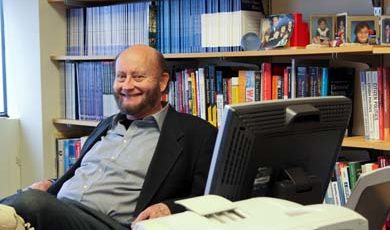Too much screen time? U-M pioneers digital wellness program for youths

Addiction, cyberbullying, eating disorders, anxiety, and other mental health issues caused by problematic digital practices and an increase in screen time are some of the themes of a new and unique U-M interprofessional Peer-to-Peer Digital Wellness class.
-
The real-life soap opera of "General Hospital" creator Frank Hursley
Behind the scenes, “General Hospital” creator Frank Hursley, AB ’25, lived a private life to rival any soap opera.
-
A tale of two Michigans
Video: At the age of 106, Lillian (Cooper) Gaines, ABEd ’27, remembers Ann Arbor at the height of the Jazz Age. “I was a dancing fool,” she says. And while he followed in her footsteps, son Harry Gaines, AB ’57/JD ’60, came to a very different U-M.
-
U-M researchers to study use of medical marijuana
A team of Medical School researchers recently received a four-year federal grant to study the impacts of marijuana on conditions related to cancer, glaucoma, pain.
-
Behind the scenes with Trey Burke at the 2013 NBA draft
Trey Burke is cool under pressure, as his performance in the 2013 NCAA Championship showed. So it should come as no surprise that on the biggest day of his life so far, the former Wolverine slept in.
-
The professor and the spirits
Professor Albert Hyma claimed an advantage over other experts on the Renaissance and Reformation. He communed with the dead.
-
To retire or not to retire?
Once upon a time, baby boomers were typecast as feckless do-nothings who cared only for sex, drugs, and rock ‘n’ roll. Lately, however, people born between 1946 and 1964 have taken on a new role: workaholic. According to a new U-M study, boomers now hitting retirement age are hanging onto their jobs like never before. In fact, some are forgetting to retire altogether.
Columns
-
President's Message
From this day forward: ‘Vision 2034’
As U-M plans for the next decade, we prioritize the safety of our present-day campus community. -
Editor's Blog
Something old, something new
Who's ready for an excellent adventure? Just keep an eye peeled for the (virtual) hot lava. -
Climate Blue
Order from disorder
Ricky Rood explains the organizing principles behind weather, which is how we feel climate. -
Health Yourself
Getting a leg up on sciatica and piriformis syndrome
Victor Katch compares and contrasts sciatica and piriformis syndrome and explains how to ease that pain in your butt.
The Art Show
Founded in 1990 with a single theatre workshop, the Prison Creative Arts Project (PCAP) is a program of U-M’s Residential College. Courses serve as gateways for undergraduate participation in prison arts workshops and provide academic training in issues surrounding incarceration and practical skills in the arts. The program’s Annual Exhibition of Artists in Michigan Prisons (“the art show”) is one of the largest exhibits of artwork by incarcerated artists in the world. The annual exhibition, free to the public, is presented with support from the Michigan Arts and Culture Council. It runs through April 2 at the Duderstadt Gallery. (Click on the images to enlarge. Images are courtesy of PCAP.) Learn more about PCAP.


















